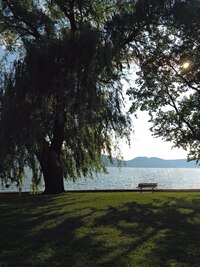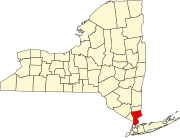
Westchester County is located in the U.S. state of New York. It is the seventh most populous county in the State of New York and the most populous north of New York City. According to the 2020 United States Census, the county had a population of 1,004,456, its highest decennial count ever and an increase of 55,344 (5.8%) from the 949,113 counted in 2010. Westchester covers an area of 450 square miles (1,200 km2), consisting of six cities, 19 towns, and 23 villages. Established in 1683, Westchester was named after the city of Chester, England. The county seat is the city of White Plains, while the most populous municipality in the county is the city of Yonkers, with 211,569 residents per the 2020 census. The county is part of the Hudson Valley region of the state.

Briarcliff Manor is a suburban village in Westchester County, New York, 30 miles (50 km) north of New York City. It is on 5.9 square miles (15 km2) of land on the east bank of the Hudson River, geographically shared by the towns of Mount Pleasant and Ossining. Briarcliff Manor includes the communities of Scarborough and Chilmark, and is served by the Scarborough station of the Metro-North Railroad's Hudson Line. A section of the village, including buildings and homes covering 376 acres (152 ha), is part of the Scarborough Historic District and was listed on the National Register of Historic Places in 1984. The village motto is "A village between two rivers", reflecting Briarcliff Manor's location between the Hudson and Pocantico Rivers. Although the Pocantico is the primary boundary between Mount Pleasant and Ossining, since its incorporation the village has spread into Mount Pleasant.
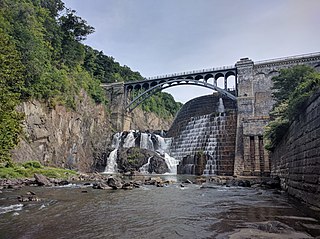
Cortlandt is a town in Westchester County, New York, United States, located at the northwestern edge of the county, at the eastern terminus of the Bear Mountain Bridge. The town includes the villages of Buchanan and Croton-on-Hudson.

Yorktown is a town on the northern border of Westchester County, New York, United States. A suburb of the New York City metropolitan area, it is approximately 38 miles (61 km) north of midtown Manhattan. The population was 36,569 at the 2020 U.S. Census.
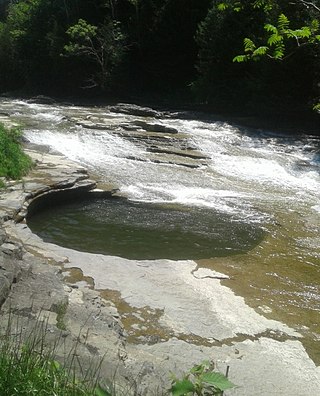
Canajoharie is a village in the Town of Canajoharie in Montgomery County, New York, United States. As of the 2010 census, the village had a population of 2,229. The name is said to be a Mohawk language term meaning "the pot that washes itself," referring to the "Canajoharie Boiling Pot," a circular gorge in the Canajoharie Creek, just south of the village.
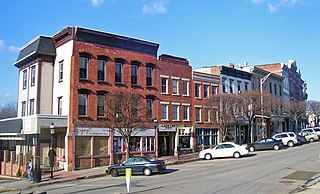
Ossining is a village in Westchester County, New York, United States. The population at the 2020 United States census was 27,551, an increase from 25,060 at the 2010 census. As a village, it is located in the town of Ossining.
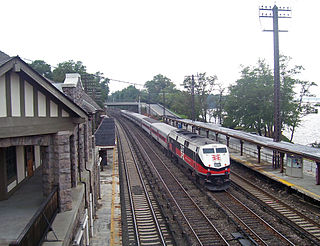
Philipse Manor station is a commuter rail stop on the Metro-North Railroad's Hudson Line, located in the Philipse Manor area of Sleepy Hollow, New York, United States.

Pierre Van Cortlandt was an American politician who served as the first lieutenant governor of New York.
The New York and Putnam Railroad, nicknamed the Old Put, was a railroad line that operated between the Bronx and Brewster in New York State. It was in close proximity to the Hudson River Railroad and New York and Harlem Railroad. All three came under ownership of the New York Central system in 1894. The railroad was abandoned starting in 1958, and most of the former roadbed has been converted to rail trail use.

Cortlandt Manor is a hamlet—an unincorporated section—of the town of Cortlandt in northern Westchester County, New York, roughly surrounding Peekskill, encompassing Corlandt Estates and lying east of three sections of the town of Cortlandt, Croton-on-Hudson, Crugers, and Montrose. It is a mostly residential area.

Montrose is a hamlet within the town of Cortlandt, in the northwestern corner of Westchester County, New York, United States. It is located near Croton-on-Hudson and Buchanan. The rural character of the hamlet is defined by the Hudson River, numerous wooded hills and steep slopes, wetland areas and beautiful streams. As of the 2010 census, Montrose had a population of 2,731.
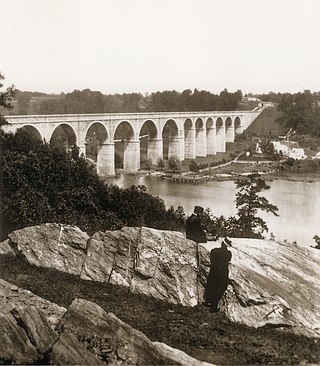
The Croton Aqueduct or Old Croton Aqueduct was a large and complex water distribution system constructed for New York City between 1837 and 1842. The great aqueducts, which were among the first in the United States, carried water by gravity 41 miles (66 km) from the Croton River in Westchester County to reservoirs in Manhattan. It was built because local water resources had become polluted and inadequate for the growing population of the city. Although the aqueduct was largely superseded by the New Croton Aqueduct, which was built in 1890, the Old Croton Aqueduct remained in service until 1955.

The Hudson Line is a commuter rail line owned and operated by the Metro-North Railroad in the U.S. state of New York. It runs north from New York City along the east shore of the Hudson River, terminating at Poughkeepsie. The line was originally the Hudson River Railroad, and eventually became the Hudson Division of the New York Central Railroad. It runs along what was the far southern leg of the Central's famed "Water Level Route" to Chicago.
Often referred to as Mt. Airy, this neighborhood is situated immediately south of Furnace Woods and north of Croton, and is partially situated in both unincorporated Cortlandt and the village of Croton-on-Hudson in Westchester County, New York, United States.

New York State Route 129 (NY 129) is a 7.75-mile (12.47 km) long state highway in the western part of Westchester County, New York. The route begins at New York State Route 9A in the village of Croton on Hudson at the Hudson River. NY 129 then travels through the towns of Cortlandt and Yorktown, running along the northern edge of the New Croton Reservoir. It passes under (southbound) and over (northbound) the Taconic State Parkway in Yorktown with no direct interchange. NY 129 ends in Yorktown at an intersection with NY 118.

Pierre Van Cortlandt Jr. was a United States representative from New York. A member of New York's Van Cortlandt family, he was the son of Pierre Van Cortlandt, an early New York political figure, and brother of Philip Van Cortlandt, who was also a U.S. Representative from New York.

Van Cortlandt Manor is a 17th-century house and property built by the Van Cortlandt family located near the confluence of the Croton and Hudson Rivers in the village of Croton-on-Hudson in Westchester County, New York, United States. The colonial era stone and brick manor house is now a museum and is a National Historic Landmark.

Teatown Lake Reservation is a nonprofit nature preserve and environmental education center in Westchester County, New York, U.S., located in the towns of Ossining, Yorktown, Cortlandt, and New Castle. The reservation includes an 1,000-acre (4.0 km2) nature preserve and education center, visited annually by around 25,000 people.

Croton North station is a disused train station on Senasqua Road in Croton-on-Hudson, New York, United States. It was built by the New York Central Railroad in the late 19th century. In 1987 it was listed on the National Register of Historic Places as Croton North Railroad Station.
There are numerous nationally and locally designated historic sites and attractions in Westchester County. These include architecturally significant manors and estates, churches, cemeteries, farmhouses, African-American heritage sites, and underground railroad depots and waystations. There are sites from pre-Revolutionary and Revolutionary times, as well as battlegrounds. Westchester County also played an important role in the development of the modern suburb, and there are many associated heritage sites and museums.
